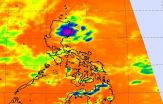(Press-News.org) MADISON, Wis. -- University of Wisconsin-Madison engineers have developed a new approach to structuring the catalysts used in essential reactions in the chemical and energy fields. The advance offers a pathway for industries to wean themselves off of platinum, one of the scarcest metals in the earth's crust.
In an effort to reduce the catalysis world's dependence on this highly reactive and versatile -- but also quite expensive -- metal, UW-Madison chemical engineering Professor Manos Mavrikakis and his collaborators have turned to the nanoscale structure of particles, arranging atoms to achieve more potent chemical reactions while using less material.
In a paper to be published July 24 in the journal Science, the researchers describe how they teased a small number of platinum atoms into hollow "cage" structures that prove to be 5.5 times as potent as conventional platinum non-hollowed particles in an oxygen-reduction reaction crucial to low temperature fuel cells.
Materials researchers at the Georgia Institute of Technology initially came across the nano cage as a potentially powerful approach, and Mavrikakis' group used its quantum mechanical modeling expertise to synthesize cages with a tiny amount of platinum.
The real significance of this research, Mavrikakis says, is less about basic chemistry and more about offering a way forward as chemical engineers work to predict and synthesize new catalytic materials, with the ultimate goal of replacing platinum and palladium with more affordable metals.
"This demonstrates a completely new concept about how you can make materials that would utilize a minimal amount of precious metals," Mavrikakis says. "Platinum is likely the most widely used catalyst in the chemical industry, which means that using less of it helps make that industry more sustainable."
To create the nano cages, researchers start with a nanoscale cube or octahedron of less expensive palladium, then deposit a few layers of platinum atoms on top of it.
Calculations by Mavrikakis' group show that platinum atoms have a tendency to burrow into the palladium during the deposition. This allows the palladium to be removed by etching agents, leaving behind a cagelike structure in the initial shape of the palladium template with faces formed by layers of platinum just three to five atoms thick.
Reactants can flow into the hollow structure through holes in the faces, interacting with more platinum atoms in the chemical reaction than would be the case on a flat sheet of platinum or traditional, nonhollowed nanoparticles.
"Because of this new structure they're taking on, they're naturally shortening the distances between platinum atoms, which makes the platinum more active for the oxygen reduction reaction," says Luke Roling, a graduate student in Mavrikakis' lab. "We're also able to use more of the platinum atoms than we were before -- at best, you could get up to twice as much of your platinum exposed."
Mavrikakis points out that, in a scaled-up version of this process, it would be possible to reuse palladium atoms after etching agents remove them from the nanoparticle. Jeff Herron, a postdoctoral researcher in Mavrikakis' group, adds that this process gives engineers a great deal of control over the shape and structure of the particle -- details that make a tremendous difference in how reactive the particle ultimately is.
"Instead of having maybe not-so-well-defined nanoparticles, you can have these well-defined facets," Herron says.
One challenge in developing the nano cage was to determine just how many atomic layers of platinum the structure needs to efficiently catalyze reactions and to be stable in the reactive environment. If it's too thin -- for example, two atomic layers -- the cage collapses. If it's too thick -- six or more layers -- it's harder to remove the palladium atoms and obtain the desired hollowed cages.
Next, researchers hope to determine the optimal nano cage facet thickness for other metallic pairings, beyond platinum on palladium.
While the UW-Madison and Georgia Tech groups have recently made other significant strides in synthesizing material structures that offer greater reactivity, Mavrikakis sees the nano cage structure has opened up a whole new avenue of investigation in synthesizing new catalysts.
"The fundamental understanding of how these materials can be formed and how their reactivity can be modulated allows us now to go well beyond this pair of elements and explore other possibilities to go after even more potent catalytic materials," says Mavrikakis, whose work was supported by the U.S. Department of Energy and UW-Madison's College of Engineering. "If your goal is to construct platinum nano cages, the question is, can you start with something even cheaper than palladium? The challenges will be there, but we've established a framework for how to address these challenges."
The discovery represents a collaborative effort between the Mavrikakis group and researchers at Georgia Tech -- led by professor Younan Xia -- Oak Ridge National Laboratory, Arizona State University and Xiamen University in China.
INFORMATION:
CONTACT: Manos Mavrikakis, 608-262-9053, emavrikakis@wisc.edu
Scott Gordon; Renee Meiller, 608-262-2481, meiller@engr.wisc.edu
MADISON, Wis. -- If you have two working eyes, you are live streaming two images of the world into your brain. Your brain combines the two to produce a view of the world that appears as though you had a single eye -- like the Cyclops from Greek mythology.
And that's a good thing, as the combination of the two images makes for a much more useful impression of the world. With one eye shut, catching a ball or parking a car become far more difficult.
"If you're reaching out with your hand, you want to aim not at where things appear to be, but where they are," says Bas Rokers, ...
Everybody grieves the death of a loved one, and the process helps most mourners adjust to their loss.
"Charlie Brown was right," said Christopher Layne, a psychologist and researcher at the Semel Institute for Neuroscience and Human Behavior at UCLA. "There is good grief."
But for some people, bereavement becomes a problem in itself, prolonging suffering and impairing functioning. For grieving children and adolescents persistent complex bereavement disorder can derail social and academic development at a time when children and adolescents need to master skills and form ...
PULLMAN, Wash.--Washington State University scientists have found that glyphosate, the main ingredient in the herbicide Roundup, does not accumulate in mother's breast milk.
Michelle McGuire, an associate professor in the WSU School of Biological Sciences, is the lead researcher of the study, the first to have its results independently verified by an accredited, outside organization.
Her findings, presented at the Federation of American Societies for Experimental Biology Conference on July 23 in Big Sky, Mont., show that glyphosate, the most used weed-killing chemical ...
Sometimes consumers might appreciate a pop-up ad that reflects the merchandise they were recently browsing online, and sometimes they just might decide to spike it and thereafter avoid the seller that placed the ad. Retailers can learn about this behavior in the September 2015 issue of the Journal of Retailing.
In "The Importance of Trust for Personalized Online Advertising," Marketing Professors Alexander Bleier, of Boston College's Carroll School of Management, and Maik Eisenbeiss, of the University of Bremen, show how trust in a particular vendor affects the degree ...
When Tropical Depression 12W formed on the northeastern tip of the Philippines in the Luzon Region, NASA's Aqua satellite captured infrared data on the newborn storm.
The Atmospheric Infrared Sounder (AIRS) instrument that flies aboard NASA's Aqua satellite captured infrared data on Tropical Depression 12W. AIRS data showed some cloud top temperatures were as cold as -63F/-53C on July 23 at 5:17 UTC (1:17 a.m. EDT). Cloud top temperatures that cold have been shown to generate heavy rainfall.
Tropical Depression 12W (TD12W) formed at 0900 UTC (5 a.m. EDT) on July 23 ...
Fairfax, Va., July 22, 2015 - The American Society for Radiation Oncology (ASTRO) is concerned about proposed additional payment cuts to radiation therapy detailed in the Centers for Medicare and Medicaid Services' (CMS) proposed Medicare Physician Fee Schedule (MPFS), released July 8, 2015, which will take effect on January 1, 2016. Freestanding centers estimate that the combined impact of the Medicare proposals would result in a five to seven percent reduction in payment for radiation oncology services at community-based centers, although the cuts will vary and could ...
Tropical Storm Felicia was born early on July 23 in the Eastern Pacific Ocean, over 400 miles southwest of Baja California's southern tip. NOAA's GOES-West satellite provided an infrared image of the newborn storm.
Previously known as tropical low pressure area "System 99E," the storm finally developed after days of remaining unorganized. NOAA's GOES-West satellite captured an image of Tropical Storm Felicia on July 23, 2015 at 15:45 UTC (11:45 a.m. EDT). Satellite imagery shows that a curved band of thunderstorms are wrapping around the southern quadrant of the storm.
The ...
Researchers in the Division of Hematology, Oncology and Blood & Marrow Transplantation at Children's Hospital Los Angeles have shown greatly improved outcomes in using stem cell transplantation to treat patients with a serious but very rare form of chronic blood cancer called juvenile myelomonocytic leukemia (JMML).
Allogeneic hematopoietic stem cell transplantation (HSCT) involves the transplantation of stem cells from a donor, which may be derived from bone marrow, peripheral blood or umbilical cord blood. The recipient's immune system is usually destroyed with radiation ...
Researchers from Scripps Institution of Oceanography at UC San Diego have accurately mapped out the movement of the devastating 7.8-magnitude Nepal earthquake that killed over 9,000 and injured over 23,000 people. Scientists have determined that the earthquake was a rupture consisting of three different stages. The study could help a rapidly growing region understand its future seismic risks.
The Himalayan region is particularly prone to earthquakes and this study will serve as an important benchmark for understanding where future earthquakes may occur, especially ...
SEDE BOQER, Israel...July 23, 2015 - Ben-Gurion University of the Negev (BGU) and University of Western Australia researchers have developed a new process to develop few-layer graphene for use in energy storage and other material applications that is faster, potentially scalable and surmounts some of the current graphene production limitations.
Graphene is a thin atomic layer of graphite (used in pencils) with numerous properties that could be valuable in a variety of applications, including medicine, electronics and energy. Discovered only 11 years ago, graphene is one ...

